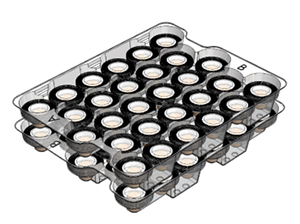
10 September 2024 | Plastics By Design
Vacuum Formed Transit Trays
Transit trays are self-stacking assembly trays designed to transport and handle parts while offering maximum protection during shipping between manufacturing facilities or to the end-user.
Commonly used for automotive, electrical, and electronic components, transit trays also play a vital role in the food, cosmetic, and clinical industries. These trays are purpose-built for in route safety, whether for heavy-duty auto parts or precision-made medical equipment.Key Features:
- Custom Design: Made specifically to house and protect your items or components.
- Robotic Loading: Designed for quick and accurate loading and unloading.
- Versatile Use: Suitable for both single-use and multi-use applications.
- Efficient Storage: Designed to be stackable during use and nestable for storage to save space.
- Durability: Resistant to oils and chemicals, ideal for industrial and clinical environments.
- Lightweight and Self-Stacking: Easy to handle and efficient for transportation.
- Flexibility: Adaptable for various uses−whether for protective storage or as logistical aids.
Plastics By Design Ltd specializes in vacuum forming and its diverse applications. The vacuum forming process is versatile, cost-effective, and allows for rapid production of prototypes before moving into full-scale manufacturing. Bespoke trays offer several advantages over standard packaging, including no set-up requirements, reduced contamination risks, and the ability for re-use and recycling.
- Material Range: Trays can be made from lightweight materials (500 microns) to heavy-duty options (up to 6mm PS/PE), depending on application needs.
- Resistant Materials: Oil and cleaning agent-resistant materials ensure trays can be cleaned and reused multiple times.
- Customization: Trays can be engraved or printed with identification codes for batch control, improving traceability and stock management.
- Better Protection: Prevents breakages during transport.
- Improved Stock Control: Easier tracking and handling of parts.
- Cost-Effective: Reduces space and shipping costs.
- Efficient Handling: Streamlines the movement of awkward components.
- Reduced Waste: Reusable and recyclable, helping meet ISO 9002 standards.